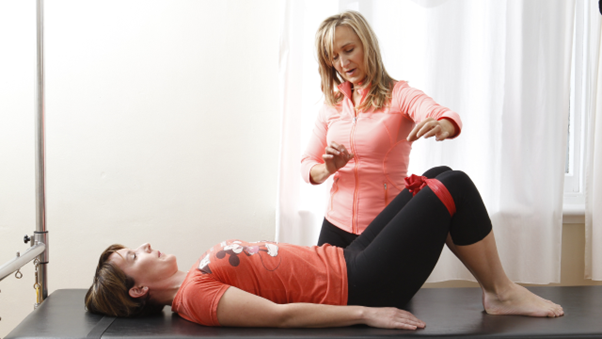
June is Pelvic Organ Prolapse (POP) Awareness Month—a timely opportunity to shine a light on a condition that affects many women but is rarely spoken about openly. As Pilates teachers, we are often in a unique position to be a confidante for our clients and help with early signs of dysfunction, guide clients toward supportive movement choices, and refer to the right professionals.
What is Pelvic Organ Prolapse?
Pelvic Organ Prolapse occurs when one or more pelvic organs—such as the bladder, uterus, rectum, or small intestine—descend into the vaginal space due to weakened or stretched pelvic floor muscles and connective tissue. It’s graded from stage 1 (mild) to stage 4 (organ protrusion outside the vaginal opening).
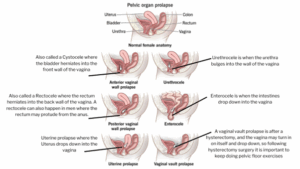
Who Gets Prolapse?
While prolapse is most common in postmenopausal women, particularly those in their 60s and 70s, it’s not exclusive to older age. It can also affect women in their 20s and 30s, especially after childbirth—particularly vaginal births or forceps deliveries. You can even experience more than one type of prolapse at the same time.
Contributing factors include:
- Pregnancy and childbirth (especially multiple or traumatic deliveries)
- Menopause (due to declining oestrogen)
- Chronic constipation and straining
- Heavy lifting or high-impact exercise
- Obesity
- Smoking and chronic coughing
Symptoms of Prolapse
Many people describe a “dragging” or “heaviness” in the pelvis or vagina, or the sensation of sitting on a small ball. Other common symptoms include:
- Discomfort or numbness during sex
- A visible or palpable bulge from the vaginal opening
- Lower back pain or pelvic pressure
- Difficulty emptying the bladder or bowels
- Feeling “not quite right” internally
- Some people may have no symptoms at all
How Pilates Can Help
Pilates can be an empowering, safe, and effective part of managing pelvic organ prolapse (POP). The key is to modify intelligently, always working in collaboration with a pelvic health physiotherapist.
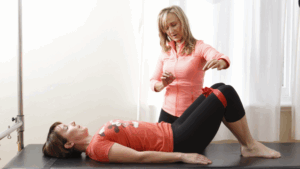
What to focus on:
- Pelvic floor coordination: Teach pelvic floor lifts in neutral spine positions like supine footwork on the Reformer, seated on the Wunda Chair or supine on the Cadillac.
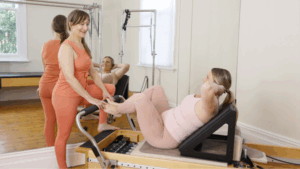
- Relaxation techniques: A tight pelvic floor can be just as dysfunctional as a weak one. Exercises like Child’s Pose mat work or with the Push Through Bar on the Cadillac, Happy Baby as mat work or with feet in straps on the Reformer, and Cat Stretch mat or Cadillac can help lengthen and relax the pelvic floor.

- Breath awareness: Encourage full, relaxed diaphragmatic breathing to improve core synergy, relaxing the abdominals can help with relaxing the pelvic floor muscles – which we all need to do for successful bowel emptying. Cue to relax the pelvic floor with an inhale, allowing the belly to soften and relax as well.
- Postural awareness: Strengthening the posterior chain and supporting spinal alignment helps take strain off the pelvic floor. Yes posture can affect the pelvic floor. When posture is slouchy, there is more pressure on the pelvic floor, so keep cueing “lengthen into the space above you”, “grow tall” and “increase the space between the pelvis and the ribcage”.
- Low-pressure positions: Lying supine, side-lying, seated, or in four-point kneeling are ideal for reducing gravitational load on a prolapsed pelvic floor.
- If you see your clients’ abdominals wall bulging, then you may also assume that there is pressure bulging at the pelvic floor also. Reduce the intra-abdominal intensity by decreasing the load.
What to Avoid
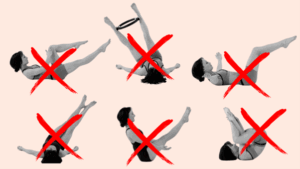
- Abdominal curls and crunches: These increase intra-abdominal pressure and may worsen prolapse. Both feet off the floor such 90/90 positions will put pressure on the pelvic floor. Hovers are also considered too much intraabdominal pressure.
- Full planks and full push up
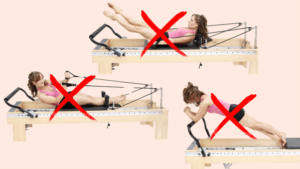
- Heavy lifting and loaded spine flexion
- Jumping or high-impact movements
- Excessive holding of the breath
- Prolonged standing exercises—for clients with advanced prolapse, prolonged upright work may increase symptoms. Encourage breaks in supine rest when possible. After a hysterectomy, choose seated exercises for 6 weeks to limit load and dropping of the pelvic floor.
How can I get a good workout then!

- Work in a closed kinetic chain for knee floats, knee drops and knee stirs
- Bridging
- Supine arm weights
- Baby pose to relax the pelvic floor
- Side lying work; clams, oysters, clam kicks, leg lifts – up/down, forward/back, circles

- Push ups from the knees
- Quadrupeds/pointer
- Child pose to release the pelvic floor
- Seated arm weights or arm springs – use one weight only in one hand to reduce weight through the body but increase resistance through the shoulder, arm and wrist. Do wrist weight exercises supported.
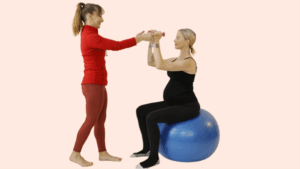
Practical Tips for Clients
- See a pelvic health physio for assessment and guidance.
- Try splinting for constipation—gently pressing the back wall of the vagina to support bowel movement (yes this means inserting a thumb or fingers) or press on the perineum to support the pelvic floor.
- Use a Squatty Potty and avoid straining—let the belly go, relax the pelvic floor, and lengthen through the spine while leaning forward.
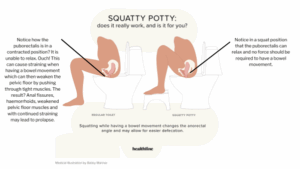
- HRT creams or tables that are inserted into the vagina may help menopausal women—but aren’t suitable for everyone – check with a doctor who specialises in menopause and women’s health.
- A vaginal pessary (a ring device that supports internal organs) can be an effective non-surgical solution, although some women find this uncomfortable.
- Sex is usually still possible—If menopausal, the vagina may have dried up, so personal lubricants may be needed or HRT creams or tablets inserted into vagina to increase tone, elasticity and moisture – talk to a GP who specialises in women’s health. Not all women can have HRT.
A little word on mesh surgery – avoid it if possible—some women have had serious and painful complications. Explore conservative options first.
A Final Word
Pelvic Organ Prolapse is incredibly common—yet too often shrouded in stigma. Pilates professionals have a powerful role to play in supporting clients with safe, informed, and compassionate guidance.
Whether you’re teaching pelvic floor lifts during Reformer footwork or gently encouraging relaxation in Happy Baby, you are helping to rewrite the narrative around this condition—one breath and one body at a time.
References & Resources
- Continence Foundation of Australia which is now Continence Health Australia
- Jean Hailes for Women’s Health
- Sue Croft’s “Pelvic Floor Recovery”
- Michelle Kenway’s “Inside Out – Pelvic Floor Safe Exercises” Book
- Cleveland Clinic
- Health Line
- I love any of Sue Croft’s publications. Both her and Michelle Kenway are Australian authors and pelvic health physiotherapists based in Queensland. Both their publications are affordable and insightful. I also love the animations from Continence Health Australia and frequently show them to clients so that they can visualise a pelvic floor lift and relaxation.
About the Author

Louise Taube is recognised as a Principal Pilates Trainer with the PAA and the founder of Taube Pilates, based in St Kilda East, Melbourne. With over 25 years of teaching experience and a strong background in both contemporary and clinical Pilates, Louise specialises in programs for active ageing, menopause, pelvic health, osteoporosis, and rehabilitation. She is known for blending evidence-informed practices with compassionate teaching and runs popular online teacher training courses on topics such as Pilates for Perimenopause, Osteoporosis, and Pregnancy & Postnatal. Louise is also a proud Pilates cat mum to Stanley and Kubrick.
You can connect with her at www.taubepilates.com or on Instagram @taubepilates or facebook @taubepilates.
PPS. You can get 30% off her courses listed in member benefits!
By Louise Taube, Taube Pilates

Comments are closed.